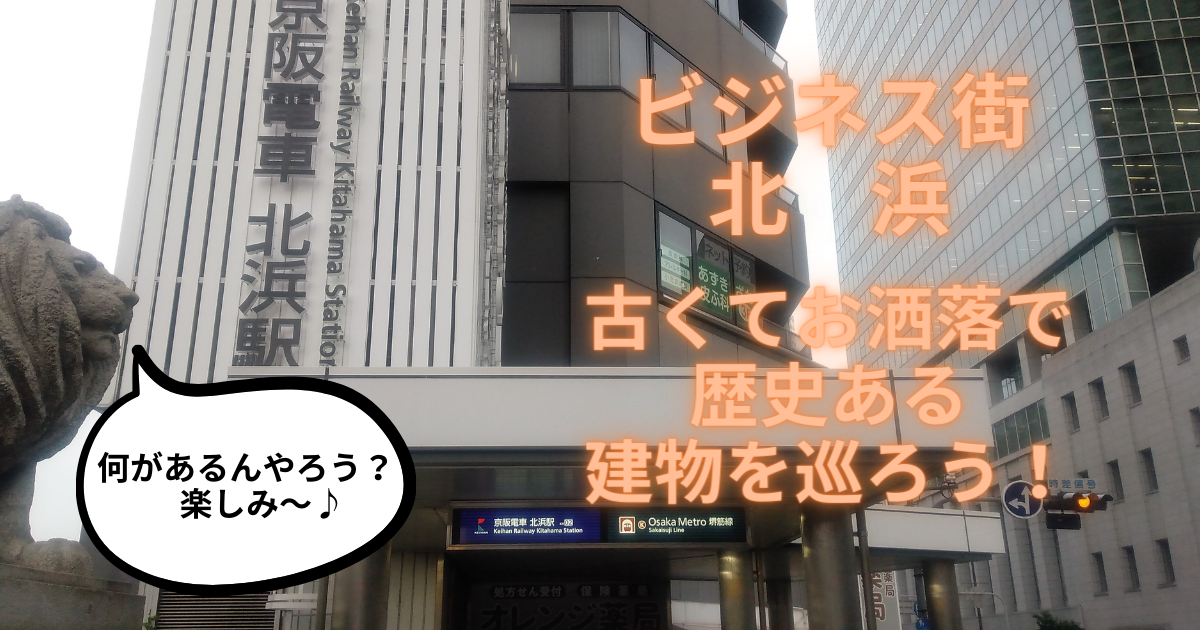When you think of tourist attractions in Osaka City, which ones come to mind?
Dotonbori, Shinsekai, Tsutenkaku Tower, Osaka Castle Park, Umeda Sky Pill, Abeno Harukas,
Tenpozan, Universal Studios Japan, etc. come to mind, don’t they?
However, I would like to introduce to you this area.
Kitahama
” What? Where is Kitahama? ” I am sure many of you must have wondered.
Kitahama is less famous than other major areas in Osaka City, e.g. Umeda, Namba, Yodoyabashi, Honmachi,
Shinsaibashi, Kyobashi, Tsuruhashi, Tennoji, Abeno, etc.
However, I dare to take up “Kitahama”.
Because, although it is an business district,
Kitahama has many old, historic, and attractive buildings.
This article is intended for the following people
・Those interested in historical buildings
・Those interested in hidden places in Osaka City
・Those who stay at accommodations in the Kitahama area and look for places to visit nearby.
By reading this article,
you will learn how many old and historically valuable buildings exist in Kitahama,
even though it is a business district.
I hope that my readers will find this article useful as a means of gathering information
when touring the various buildings in Kitahama in the future.
Well then, let’s read this article.
What kind of place in Kitahama?

Kitahama, located in the northern part of Chuo Ward, Osaka City, is famous as a business district.
Because there are many financial companies such as banks and securities firms in the vicinity,
it is also known as Osaka’s financial district.
The building that symbolizes Kitahama is here. Osaka Exchange The building is the Osaka Exchange.


It used to be called the “Osaka Securities Exchange”.
The Osaka Securities Exchange was merged with the Tokyo Stock Exchange.
The physical trading of stocks conducted on the Osaka Securities Exchange will be transferred to the Tokyo Stock Exchange.
It is therefore now called the “Osaka Exchange”.
*Quoted from the article in the blog site “From job hunting to stock investment, Jojo kigyo (listed companies) labo “, “What is the Osaka Exchange (formerly the Osaka Securities Exchange)?
For more information on the Osaka Exchange, please refer to this page.
Tours of the building are also available.
If you are interested, please refer to this page.

This is the bronze statue of “Tomoatsu Godai”.
Mr. Godai, who was born in Kagoshima Prefecture in 1836 (Tempo 6), founded the Osaka Stock Exchange (now the Osaka Exchange) in 1878 (Meiji 11) with like-minded Osaka businessmen.
As the first chairman, he devoted himself to promoting industrial modernization and laying the foundation for Osaka’s economic development.
I didn’t learn about Mr. Godai until I wrote this article.
I recognized again that we are able to live in affluence today
thanks to the efforts of Mr. Godai and other predecessors.
Besides office buildings, accommodations, and tower apartments,
Kitahama has many old and historic buildings.
Many are still in use today and offer a fascinating blend of new and old.
The streets are less crowded than in major tourist areas in Osaka City.
Since it is a business district, it is crowded on weekdays with people working at companies in the Kitahama area.
However, on weekends and holidays, the streets are less crowded, so you can take time strolling around.
I love the quiet and relaxed atmosphere in Kitahama.

Sakaisuji street, a one-way major road running north-south through the center of Kitahama.
The Osaka Metro Sakaisuji Line runs directly under this street.
Also, if you exit Kitahama Station and go a little north, you will find Nakanoshima island.



There are many historical buildings in Nakanoshima.
I refrain from introducing it at this time.
If I have the opportunity, I will try to write an article about Nakanoshima in the future.
Now let’s actually stroll around Kitahama and visit the historical buildings.
Historical buildings in Kitahama
Let me introduce some of the old, fashionable, and historical buildings in Kitahama.
The buildings introduced here still function today as restaurants, financial institutions, etc.
Why not visit these buildings while thinking back to the time when they were first opened?
Sumitomo Mitsui Banking Corporation, Osaka Chuo Branch


Located on the north side of Exit 4 of Kitahama Station on the Osaka Metro Sakaisuji Line.
It was built in 1936 (Showa 11) and is designated as a tangible cultural property of Osaka City.
It is hard to believe that it was built about 90 years ago.
It is beautifully preserved.
According to the information on SMBC’s official website,
a new building adjacent to the rear of this building, the main building, is to be rebuit into
a building with 2 basement floors and 31 floors above ground.
It is scheduled to open in 2030 (Reiwa 12).
Accordingly, “the main building will be partially restored to its original appearance and interior as it was when it was built, while improving safety.
This is how we enhance its value as a cultural asset (quoted from SMBC’s website)”.
*For details, please refer to this page.
Arai Building

This is the Arai Building.
Construction was completed in 1922 (Taisho 11) as the Osaka branch of the former Houtoku Bank.

It is currently occupied by the Kitahama main store of GOKAN, a famous confectionery store in Osaka.
I, hiikun, also love the sweets of Gokan.
I have purchased Gokan’s sweets from a store in a department store.
However, this is the first time I have visited the Kitahama main store.
It looks more beautiful when visited later in the evening than during the day.
I plan to talk about “GOKAN” in detail
in another article at a later date.
Please look forward to it.
For the official website of the Arai Building, go here .
Koraibashi Nomura Building


This office building was completed in 1927 (Showa 2).
It is located directly across the street from the Sumitomo Mitsui Banking Corporation Osaka Chuo Branch mentioned earlier.
On the first floor, St. Mark’s Cafe Osaka Kitahama shop and
The Soke Genkitchoan Koraibashi branch, a Japanese confectionery store, are housed in the building.
Located a 1-minute walk from Exit 6 of Kitahama Station on the Osaka Metro Sakaisuji Line.
Former Konishi Family Residence Archives
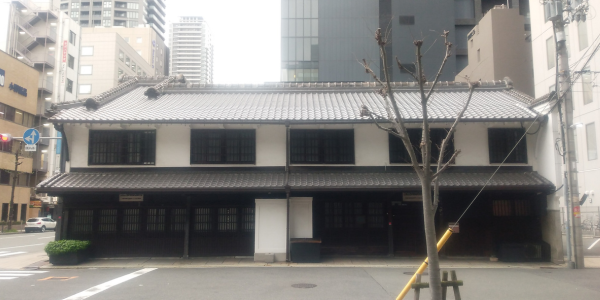
It is a historical building owned by Konishi Corporation, a comprehensive manufacturer of adhesives.
You are familiar with the synthetic adhesive “Bondo”.

This building is the former office building of Konishi Co.
It was built in 1903 (Meiji 36).
It is amazing that it has existed as it was for more than 120 years.
It is currently used as a historical museum.
Reservations are required for tours.
Please refer to this page for details.

Former Konishi Family Residence Museum and tower apartment.
This contrast between 120-year-old and modern buildings is a lovely sight.
Will the former Konishi Family Residence Museum still exist 100 years from now, in the year 2124?
Unfortunately, I hiikun will surely die without seeing it happen.
*If I were alive, I would be 144 years old, a monster, lol.
I captured it in a photo,
hoping that, as long as Japan continues to be Japan after my death,
historically valuable buildings like this one will continue to exist.
Ikoma Building


This is Ikoma Building.
As the main store of Ikoma Watch Co., Ltd., founded in 1870(Meiji 3),
it was built in 1930 (Showa 5).
It was designated as a National Tangible Cultural Property in 1997 (Heisei 9).

There is a stylish Italian bar on the first floor.
If you are interested in the interior of the building, please refer to this page.
You can see the inside of the building through a virtual tour.
I, hiikun, also experienced the virtual tour.
I was surprised to find that the interior of the building was kept in a much cleaner condition than I had imagined.
I went to a place to take a break…
I was getting tired of walking around to take pictures of each building.
So I headed to a place for a break.

“Huh? Aren’t you going to Nakanoshima?” I am sure some of you must have wondered.
Of course, I could have taken a break in Nakanoshima.
This time, however, I dare to head elsewhere.
Go east on the street along the Osaka Exchange.

Then you will see the highway.
What is noteworthy is what lies beneath it.

There is a river flowing in such a place.
This is “Higashi Yokobori River”.

There is a rest area along the river where you can take a break.

A boardwalk is in place and is surprisingly long.

Here’s a question for you, dear readers.
If you walk down the Higashi Yokobori River here, you will reach a famous place.
Where is it?
I will give you 10 seconds to think about it.
10
9
8
7
6
5
4
3
2
1
0
I will now announce the correct answer.
The correct answer is…

You can reach the Dotonbori area.
In fact, if you look at the Higashi Yokobori River from above, you can see that it has an inverted L-shaped side.
The Higashi Yokobori River turns right on the way. After that, it becomes the Dotonbori River.
I wonder how many people know
that there is such a quiet and serene place upstream from the Dotonbori River.

Here I decided to eat the sweets I purchased at “Gokan”.
What is inside?

I would like to show you,
but I will reveal it in an article on “Gokan” to be posted at a later date.
Please wait until then.
Next, let me introduce to you a hidden shrine in the business district of Kitahama.
Sukunahikona Shrine

This is Sukunahikona Shrine.
Doshomachi district, Chuo Ward, Osaka City, where this shrine is located, is famous as a “medicine town.
There have been numerous drug wholesalers in this area since the Edo period.
Several pharmaceutical companies still have their headquarters or branch offices in this area.

Located in Doshomachi is the Sukunahikona Shrine.
It is the very small shrine.
Some people may not notice it because it is tucked between buildings.
I, hiikun, almost passed by it without noticing.
It was even a little difficult for me to find.
Sukunahikona Shrine was founded in 1780 (Anei 9), some 240 years ago.
The shrine is dedicated to “Sunahikono-no-mikoto,” the god of medicine who also appears in Japanese mythology, and “Enteishinno,” who is said to have taught people medicine and agriculture in ancient China.
Locally, it is known by the nickname “Shinno-san”.
Many people visit this shrine to pray for good health and healing from illness.
As I said at the beginning, there are several pharmaceutical companies in the vicinity.
People working in pharmaceutical companies and medical professionals also visit the shrine.
In addition, some people visit this shrine
to pray for the acquisition of medical qualifications and for success in entrance exams to medical colleges and vocational schools.

Exit 6 of Kitahama Station on the Osaka Metro Sakaisuji Line.
Exit here and proceed south.
Continue to the second corner and you will see a large pharmacy sign.

It is easy to understand because there is a traffic light.
Turn right there and go about 20 meters…
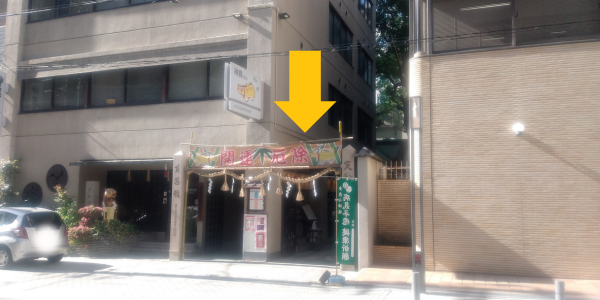
You will see the entrance and exit of the Sukunahikona Shrine on your right.
The entrance is on the right and the exit is on the left.
Now let’s go inside.

Once you take even a single step into the grounds of the shrine, you are enveloped in a quiet and sacred atmosphere.
It is hard to believe that you are in a bustling business district.



A map of the area and a digital information board are located on the pathway leading to the torii gate.
Foreign visitors to the temple can also check the information in English.

Bow and enter.

After passing through the torii gate, you can see a large sacred tree on the right.
It is a fairly thick and tall tree.

I, hiikun, also visited the shrine.
Being grateful to be able to live in good health every day,
I prayed that I would continue to be healthy and not suffer from any serious illnesses.

I received a “goshuin”, which is a red seal stamp given to worshippers and visitors to shrines and temples.
A green dragon is painted in the upper left corner, and the written text is powerful.
Seeing this “goshuin” will raise awareness of the need to pay more attention to my health.

Now that I have finished praying, I leave the shrine.

Many “ema”, which are wooden plaques with a wish, are displayed in the aisles.
Prayers for health and healing of illness.
Prayers for something related to obtaining medical qualifications and passing entrance examinations for medical colleges and universities.
Various wishes are written on the “ema”.
I hope everyone’s wishes are fulfilled.
The Sukunahikona Shrine is also famous for “prayers for the health of pets.
At this shrine, pets are considered important members of the family.
They also accept prayers for pets.
I recommend that pet owners visit this shrine for prayers.
For more information about the Sukunahikona Shrine, please refer to the official website.
Hokkyokusei Kitahama

This is the Aoyama Building, which was built in 1921 (Taisho 10).
It is a very valuable building designated as a nationally registered intangible cultural property and an urban landscape resource of Osaka City.
It is still occupied by several restaurants and offices,
It is still functioning well over 100 years after it was built.
The other day I had dinner at a restaurant in this building.

Famous for its omelette rice (omuraisu) , this is the Western-style restaurant “Hokkyokusei, Kitahama Restaurant”.
Hokkyokusei is a yoshoku* (western-style) restaurant that originated in Osaka. *In Japan, the term ‘yōshoku’ – Western food – is used to refer to all those dishes originating in Europe or North America that have been adapted to the Japanese palate and preference. This cuisine differs from the traditional Japanese cuisine, known as washoku and to which specialties such as tempura and sushi belong.
It has several restaurants in Osaka and other parts of the Kansai region.
Hokkyokusei was founded in 1922 (Taisho 11), the year after the Aoyama Building was built.
I, hiikun, have had omelette rice several times at some other branches of Hokkyokusei.
However, this was my first visit to the Kitahama restaurant.
I visited to look for material for my blog writing.
There are two other reasons.
One was an irresistible craving for omelette rice,
The other is to celebrate my good health with a favorite meal.
As I said in my previous post,
from late February until the end of March, I was not feeling well.
I did not have a fever, but I suffered from a terrible cough and chest pain.
However, thanks to the medications I took and adequate rest, I made a full recovery.
So, I decided to celebrate my recovery by eating what I like.
I decided to go to a place I don’t usually visit.
I chose this Kitahama restaurant of Kitakkusei.

This is exit 6 of Kitahama Station on the Osaka Metro Sakaisuji Line.
When you exit the station, go south a short distance and…

You will see the pharmacy “Hanshin Drug” on your right.
Keep to the right at that corner.

You are already there.
How easy!
The sun was so strong that I had to take pictures from odd angles.
I apologize for the difficulty in seeing.
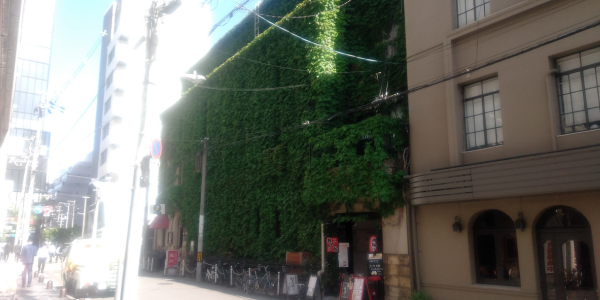
The entire building looks like this.
As I said at the beginning of this section,
in addition to Hokkyokusei, this building has several other restaurants.


This is the menu sign in front of the entrance.
They all look delicious.
Here is the meal I ate. What do you think it is?

First, a toast with beer.
I was excited because I could drink alcohol, which I had been refusing for about a month and a half.

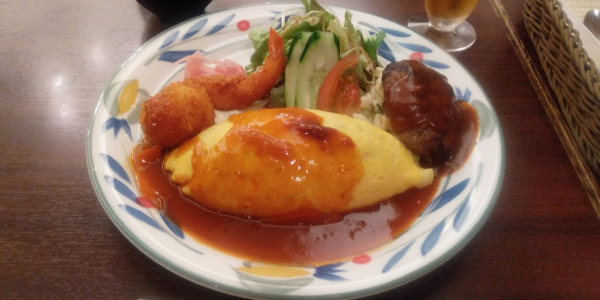
Here is the “Yoshoku set” that I, hiikun, had.
Omelette rice, hamburger steak, fried shrimp, crab cream croquette, and salad.
The price is ¥1,500 with miso soup.
It looks vibrant and appetizing.
Then, I will have it! Itadakimasu!

Ketchup sauce goes well with omelette rice.
Omelette rice with demi-glace sauce is also often seen.
I like that too, but I, hiikun, prefer omelette rice with ketchup sauce.
The eggs were fluffy and tender.
I felt a professional taste that amateurs can never imitate.


The accompanying fried shrimp, crab cream croquettes and hamburger steak were also delicious.
It would be better if they were a little larger.
Still, the taste was perfect.

Thank you for the meal. Gochisousamadesita!
In the building built over 100 years ago,
I had a wonderful time with delicious food and drink.
It was a wonderful get well celebration.
For the official Arctic Star website, go here.
Finally, let me introduce to you a place that I visited after dining at Hokkyokusei.
≪Advertisement≫.
送料無料 大阪/オムライス発祥のお店「北極星」北極星監修 ビーフカレーとハヤシの4食セット 北極星カレー160g×2、北極星ハヤシ150g×2、計4袋濃厚 旨み お中元 ギフト 家庭応援 贈り物 人気商品
オムライス発祥の店 大阪 北極星 監修 人気のファミリーセット オムライス230g×3袋 ハンバーグ260g×2袋 送料無料 冷凍 名店 人気 お得セット レンチン
北極星 特製唐揚げ 山椒塩付 230g 唐揚げ からあげ 鶏モモ 山椒塩
Kitahama Retro

Last but not least,
“Kitahama Retro” is an English traditional confectionery shop and coffee shop.
After eating Hokkyokusei introduced earlier,
I visited this shop because I had some time.

It was built in 1912 (Meiji 45 / Taisho 1) as a meeting place for stock-related people in Kitahama.
It is a very valuable building designated as a National Tangible Cultural Property.
Step inside and you are in England.
You will feel as if you were in England.

Peach-colored arrow→Exit 26, Kitahama Station on Osaka Metro Sakaisuji Line and Keihan Electric Railway
Yellow arrow -> Kitahama Retro
It takes only one minute to walk east from the station.

I visited it at about 6:50 p.m. on a weekday.
Even though it was close to closing time,
the store was rather crowded with take-out customers.
I cannot finish dinner without dessert,
I bought some items and took them home.

Fresh chocolate cake (700 yen).
It may be hard to tell from the picture.
This cake is surprisingly large.

Many teas are also available for sale.
I chose the Nakanoshima Afternoon Tea Bag 3g x 5 bags (¥650 ).
It has a gentle aroma and taste, and goes well with cakes.

I had a “Yoshoku set” and a beer at Hokkyokusei and was close to full.
Still, I ate it up.
Thanks to the moderate sourness of the raspberries,
it was lighter than I expected and tasted good.
I was interested in eating and drinking in the restaurant, so I visited it again later.
But ・・・・
It was crazy crowded.
I visited it around 5:00 p.m. and it kept crowded.
There is even a line in front of the restaurant at certain times of the day.
I had no choice but to buy a sandwich and a cake to go.

Mixed sandwich (¥1,100).
I thought it was a little expensive for a sandwich.
However, I was convinced by the quantity.


It has a two-tiered structure.
It was surprisingly large and had more ingredients than I had expected.
If possible,
I wanted to eat sandwiches with a cup of tea.
I’m sorry that didn’t happen.
But it was delicious, so let’s call it good.


What I ate as dessert was・・・
yamomori (heaps of) raspberry shortcake (700 yen).
I had it with tea.
It is the same size as the raw chocolate cake introduced earlier.
I always have room for dessert.
Even though I was full from sandwiches and beer,
I ate it all up in no time.
I would like to dine in the restaurant next time.
If you are interested in what is going on in the store,
please refer to the official website of Kitahama Retro.
Summary
What do you think of this tour of historical buildings in the business district of Kitahama?
You may have been surprised to learn that there were quite a few historical buildings along Sakaisuji Street alone.
As well as in the nearby business districts of Yodoyabashi and Hommachi,
there are several old and fashionable historical buildings.
If I have a chance, I would like to visit them as well.
Most of the places I visited are office buildings.
Therefore, entry may be prohibited or greatly restricted.
Even if you are allowed to enter, you must not take photos or videos without permission.
It is advisable to check with the owner of the building in advance to see if entry and photography are allowed.
Even if photography inside the building is allowed,
please remember to be considerate of the companies that occupy the building and the people who work there.
Tours of some buildings are also available.
That is one way to take advantage of it to see the inside of these buildings.
For example, at the Osaka Exchange and the Former Konishi Family Residence Museum,
You can sign up for a tour online.
Also from the official website of Ikoma Building ,
onle tour is also available.
I, hiikun, am also very interested in what the interior of each building looks like.
With the exception of restaurants, I refrained from entering these buildings.
More than that, the fact that these buildings still exist today is a wonderful thing in itself,
Just looking at it from the outside was enjoyable enough.
With gratitude for the knowledge, skills, passion, and efforts of our predecessors who were involved in the construction of these buildings,
I shall finish writing this article.
This is a very long article.
Thank you very much for reading to the end.
See you in the next article.

